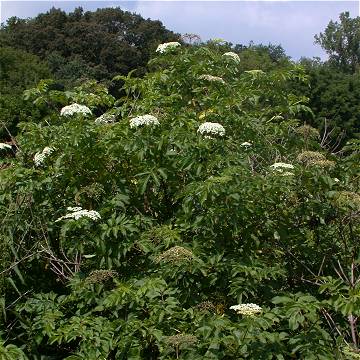

Sambucus canadensis - (image 1 of 5)
Taxonomy
Family: Caprifoliaceae
Habitat
Woodlands, shaded floodplains. Common along roadsides, fencerows, and small streams.
Associates
Distribution
Nova Scotia and Quebec west to Manitoba and SD, south to Mexico and the West Indies.
Morphology
Deciduous shrub to 3 m. Leaves pinnate compound; leaflets sharply serrate, elliptic. Stems green, become pale brown and woody with age; pith white. Flowers in compound panicles; petals 5, white; stamens 5. Fruit a purple-black berry.
Notes
Flowers early June to late August
Wetland indicator: Facultative Wetland -
This shrub attains its best form in full sun. The fruit has an unpleasant smell and taste when fresh but this property is removed by cooking. Properly prepared fruit can be used to make juice, preserves, or to make wine. The dried fruit can also be added to bake goods. Roots, stems, leaves and unripe fruit are poisonous.
References
Gleason, Henry A. and A. Cronquist. 1991. Manual of Vascular Plants of Northeastern United States and Adjacent Canada. Second Ed.
The New York Botanical Garden. Bronx, NY
Peterson, L. A. 1977. A Field Guide to Edible Wild Plants: Eastern and central North America
Houghton Mifflin Company. New York, NY
Swink, F. and G. Wilhelm. 1994. Plants of the Chicago Region.
Indiana Academy of Science. The Morton Arboretum. Lisle, Illinois.
|
Michael Hough © 2005 |